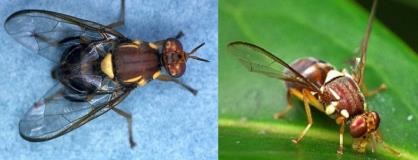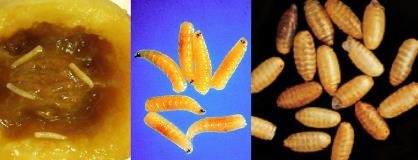Pest control
The Queensland fruit fly is a pest species that can devastate commercial and backyard fruit crops. There are a number of things you can do to help keep fruit fly at bay.
Preventing Queensland fruit flies
You can do many things to prevent Queensland fruit flies from becoming established in our shire. These include:
- avoiding bringing in fruit from other areas, particularly those known to have fruit fly
- setting traps to monitor and reduce fruit fly numbers (watch the videos to see how you can make your own or talk to your local garden supplier about the different types)
- disposing of infected fruit properly including fallen fruit on the ground
- removing unwanted fruit from trees
- keeping fruit trees well pruned
- place fruit fly nets over your fruit trees and vegetables.
Identifying Queensland fruit flies
The fly is about 5-8mm long with reddish eyes. The fly is brown with yellow ‘shoulder pads’ and other markings including a yellow triangle at the base of the mid-section.
The larvae are white or cream and 2-9 mm long. They are wedge shaped and plumper at the tail end. A black feeding hook is visible in mature larvae. You can find between 2 and 20 larvae in the fruit.
The pupae are like a large grain of brown rice and vary in colour from cream to brown.
The fruit, when infected, becomes soft and spongy and may start to rot. You may see sting marks on light coloured fruit. The flies may eat all the fruit and leave the skin.

Image above:
Adult female Queensland fruit fly (Agriculture Victoria), Adult Queensland fruit fly (James Niland).

Image above:
Fruit fly larvae in stone fruit (Applied Horticultural Research), fruit fly larvae (Agriculture Victoria), fruit fly pupae (Applied Horticultural Research).
Year round tips to prevent Queensland fruit flies
Winter
- Males become active in late winter and early spring when they begin to mate. This is the time to monitor with fruit fly traps.
- Prune trees to a manageable height for ease of fruit picking and netting.
- Replace unwanted fruit fly host trees with non-host plans.
- Pick up fallen fruit.
Remember: In the winter the risk of fruit fly is lower but winter fruits can provide a food source for overwintering fruit flies. These include apples, pears, quinces and pomegranates left hanging on trees and ripe winter citrus such as oranges, mandarins and grapefruit. Fruit fly may hibernate in citrus trees throughout winter.
Spring
- Remove fruit fly host plants if you are not going to control fruit fly in your garden.
- Design your vegetable garden layout and cropping cycles so that fruit fly populations don’t build up.
- Set up traps to monitor for fruit fly and check traps weekly.
- Pick and dispose of any excess ripe citrus especially grapefruit and late season oranges.
- Pick up and dispose of any fallen loquats.
- Spray high risk fruit if appropriate and always follow label instructions.
Remember: In spring high risk fruits are late season citrus such as grapefruit and early ripening hosts such as loquats.
Summer
- Net your vegetable garden or bag individual fruit.
- Pick up fallen fruit everyday.
- Check tomatoes and fruit for sting marks.
- Heat treat fallen and infested fruit and vegetables to kill Queensland fruit fly maggots.
- Continue to trap and monitor fruit fly population levels weekly.
- Spray high risk fruit if appropriate and always follow label instructions.
Remember: In summer high risk fruits are stone fruit such as cherries, apricots, peaches, nectarines and plums. High risk vegetables are tomatoes, capsicums and chillies.
Autumn
- Pick up any fallen fruit to break the fruit fly lifecycle.
- Heat treat fallen and infested fruit to fill the fruit fly maggots.
- Continue to monitor for fruit fly and check traps weekly.
- Continue to spray high risk fruit if appropriate and always follow label instructions.
Remember: In autumn high risk fruits are pome fruits such as apples, pears and quinces, early citrus such as mandarins. Other fruit includes pomegranates and ornamental fruiting plants such as fejoa.
This information was sourced from the Season calendar of backyard jobs by the Goulburn Murray Valley Regional Fruit Fly Group.
Manging a Queensland fruit fly outbreak
Harcourt Valley Fruit Fly Action Group has developed an Emergency Outbreak Plan which provides a step-by-step plan in the event of an outbreak of Queensland fruit fly. It outlines how to manage and contain the outbreak from identifying fruit fly through to eradication. The plan can be adapted for other communities in the shire.
The group developed the emergency plan for residential backyard growers, schools and small horticultural producers. The team worked with Council to develop the plan supported by a grant from Agriculture Victoria. They also created the Harcourt Valley Fruit Fly Action Plan 2018-2019 which aims to prevent Queensland Fruit Fly from establishing in the Harcourt Valley. A key component of this to build awareness and education.
If you live in Mount Alexander Shire and have found larvae or an adult fruit fly in your monitoring trap this is what you do.
Confirm the identity
See above: Identifying Queensland fruit flies.
Destroy infected fruit
If you have found larvae or Queensland fruit fly in your produce the best thing to do is to destroy the infected fruit straight away. You need to treat all fallen, damaged and stung fruit. This may mean removing all remaining fruit on the tree or plants. Experts recommend you treat any fruit containing larvae in this way.
Treat infected fruit by microwaving, freezing or placing the fruit in a sealed black plastic bag and leaving in the sun for at least seven days. The fruit must be disposed of in the rubbish bin, not in the compost or in green waste.
Alert the community
Once there is a confirmed case of fruit fly it’s important that the community is made aware of it and can take steps to contain the outbreak. In the first instance talk with your neighbours and suggest they put a monitoring trap on their property.
To report an outbreak of fruit fly in Mount Alexander Shire please contact Council’s Public and Environmental Health Team on 5471 1700.
To report an outbreak in In Harcourt contact Terry Willis from the Harcourt Valley Fruit Fly Action Group at harcourtfruitfly@gmail.com. The group will contact major commercial orchardists or growers.
Outside of Mount Alexander Shire you can call Agriculture Victoria on 136 186 to be directed to the appropriate team.
Monitor with traps
After you remove and destroy the fruit put up a male fruit fly monitoring trap.
Monitoring with traps allows you to see if male flies are present and whether they are increasing or decreasing in number. This is an important part of containing an outbreak.
Council has a number of outbreak kits which includes lures, male traps, female traps, letters, stickers, letters to local residents and spreadsheets for monitoring the traps. See the outbreak plan for more details.
The Harcourt Valley Emergency Outbreak Plan outlines details on setting up a fruit fly trap monitoring program. The monitoring program can be led by individuals or local groups.
Eradicate and exclude
The plan outlines how to best eradicate fruit fly through a baiting and trap control program. See the plan for details on the recommended approach which includes the use of protein baits and insecticides (including organic option of spinosad).
Along with baiting you can also install netting or place fruit bags over your produce to prevent female fruit flies from accessing the fruit and laying eggs. However, the females can lay eggs into fruit if the netting or bags are too close to the fruit.
Consider wildlife friendly netting. White coloured shade cloth or other coverings with fine mesh can be effective.
Don’t forget to remove and destroy all fallen, stung and damaged fruit by boiling, solarising, microwaving or freezing.
Remove annual plants that are affected (e.g. tomatoes, capsicums). Consider removal of abandoned or unmanaged host trees. Contact Council if there are trees on public areas you think may be infected.
Continue the eradication program until monitoring traps are clear.
Meet Ernie the Queensland Fruit Fly
To increase community awareness of Queensland fruit flies and explain what we can all do to prevent further spread, Council created a series of educational videos in partnership with City of Greater Bendigo. Thanks to Agriculture Victoria for their grant to support this work.
Video: Pruning for success
Video: How to make a trap
Video: Garden hygiene
Video: Exclusion is key
Video: Best practice
Looking for more information?
There's a range of resources available to help prevent Queensland fruit fly.